Friday, September 15
• This evening Saturn's biggest and brightest moon, Titan, glimmers about four ring-lengths to Saturn's east. A 3-inch telescope can pick it up. A 4-inch will begin to show Titan's orange color, caused by its smoggy atmosphere.
Can you see more moons around Saturn? Identify them at any time and date with our Saturn's Moons tool or iPhone app.
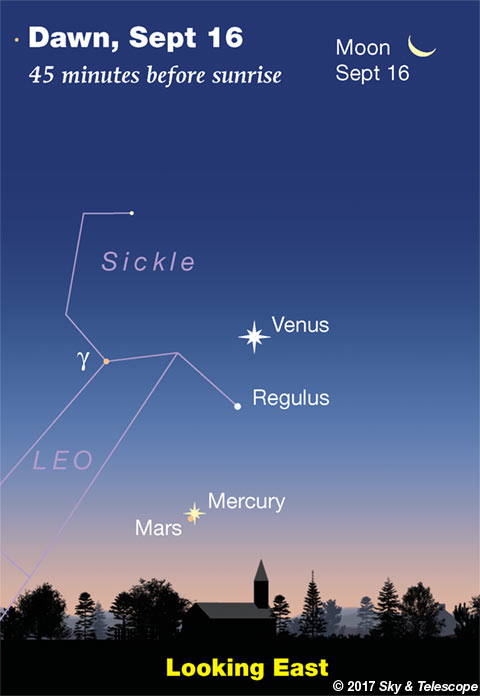
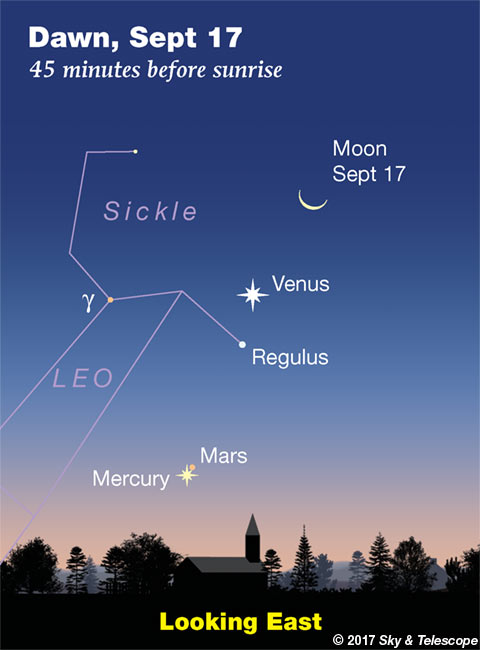
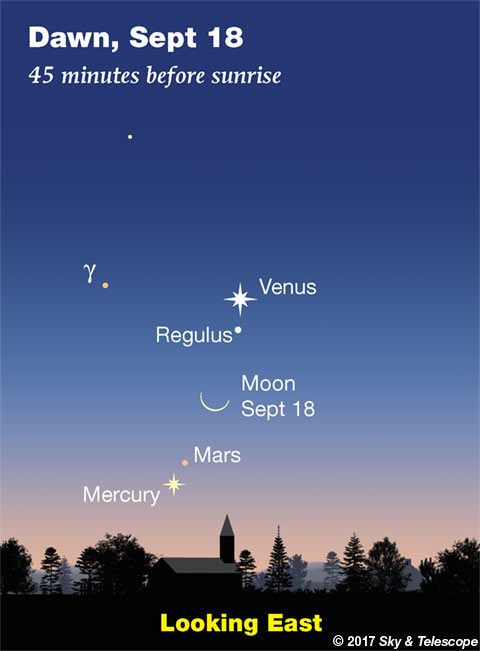
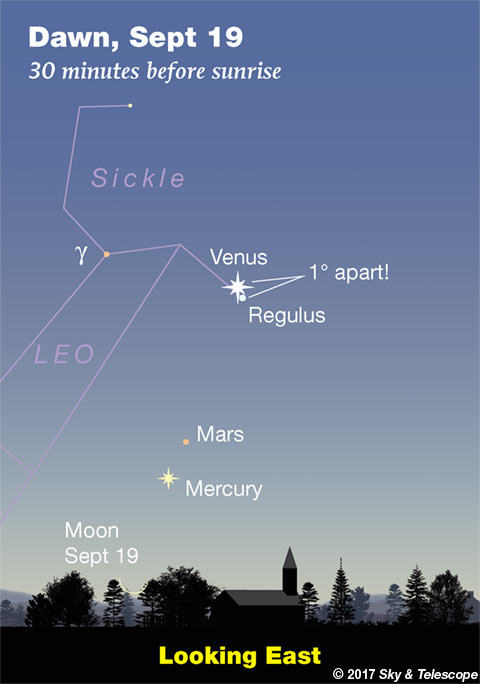
• Before sunrise on Sunday morning September 16th, Mercury is only about 0.3° from dimmer Mars, as shown at right. Bring optical aid to scan for them very low in the east, 11° lower left of Venus. Along the way you'll hit Regulus, just a bit brighter than Mars.
Saturday, September 16
• On Sunday morning the 17th, the Moon and Venus point diagonally down toward Mercury and Mars, which appear nearly as close together as they did on Saturday morning. And look for Regulus, a bit brighter than Mars, 4° or 5° below Venus.
Sunday, September 17
• As dusk turns to night, Arcturus twinkles due west. It's getting lower every week. Off to its right in the northwest, the Big Dipper is turning more and more level.
• In early dawn Monday morning the 18th, Venus, Regulus, the hair-thin waning crescent Moon, faint Mars, and Mercury form a nearly vertical line low in the east, in that order from top to bottom, as shown below. The line is about 12° tall. Bring binoculars.
Monday, September 18
• Less than 1° separates brilliant Venus and tiny Regulus as dawn brightens Tuesday and Wednesday mornings September 19th and 20th. Look low in the east, and bring those binoculars.
Tuesday, September 19
• The Great Square of Pegasus is high in the east after dark, balancing on one corner.
From the Great Square's left corner extends a big line of three 2nd-magnitude stars, running to the lower left, that mark the head, backbone and bright leg of the constellation Andromeda. (The line of three includes the Square's left corner, her head.) Upper left from the foot of this line, you'll find W-shaped Cassiopeia tilting up.
Wednesday, September 20
• New Moon (exact at 1:30 a.m. on the 20th EDT).
• With the Moon out of the sky, try for the big, elongated, 10.4-magnitude galaxy NGC 7331 above the top corner of the Great Square of Pegasus — using Matt Wedel's Binocular Highlight chart and article in the September Sky & Telescope, page 43. Really, binoculars? For a galaxy as faint as 10.4? Says Matt, "I've needed at least 10×50s to pull it out, and 15×70s are better still. Some claim to have spotted it with only 7×50s in only moderately dark skies."
For users of big telescopes under darker skies, NGC 7331 is also known as the stepping stone to Stephan's Quintet, ½° to the south-southwest.
Thursday, September 21
• As summer ends, the Sagittarius Teapot moves west of due south during evening and tips increasingly far over, as if pouring out the last of summer.
• More deep-sky hunting! M17 in northernmost Sagittarius, the Omega or Swan Nebula (it looks like either shape), is one of the brightest and richest nebulae for amateur telescopes. See Howard Banich's guide to its details, with photos and sketches and charts, on page 57 of the September Sky & Telescope. How much of this can you detect here for yourself?
Friday, September 22
• Spot the thin waxing crescent Moon low in the west-southwest during twilight. Can you see Jupiter about 7° to its lower right? (That 7° is their separation for skywatchers in North America.)
• Equinox: Autumn begins in the Northern Hemisphere, and spring in the Southern Hemisphere, at 4:02 p.m. EDT. This is when the Sun crosses the equator (both Earth's equator and the celestial equator) heading south for the season.
• Coincidentally, every year around when summer turns to fall, Deneb takes over from brighter Vega as the zenith star right around when twilight fades into night (for skywatchers at mid-northern latitudes).
Saturday, September 23
• Saturn's brightest moon, Titan, now stands about four ring-lengths to Saturn's west. Titan circles Saturn every 16 days, so it takes 8 days to move east-west from one elongation to the other.
________________________
Want to become a better astronomer? Learn your way around the constellations! They're the key to locating everything fainter and deeper to hunt with binoculars or a telescope.
This is an outdoor nature hobby. For an easy-to-use constellation guide covering the whole evening sky, use the big monthly map in the center of each issue of Sky & Telescope, the essential guide to astronomy.

Once you get a telescope, to put it to good use you'll need a detailed, large-scale sky atlas (set of charts). The basic standard is the Pocket Sky Atlas (in either the original or Jumbo Edition), which shows stars to magnitude 7.6.
Next up is the larger and deeper Sky Atlas 2000.0, plotting stars to magnitude 8.5; nearly three times as many. The next up, once you know your way around, is the even larger Uranometria 2000.0 (stars to magnitude 9.75). And read how to use sky charts with a telescope.
You'll also want a good deep-sky guidebook, such as Sue French's Deep-Sky Wonders collection (which includes its own charts), Sky Atlas 2000.0 Companion by Strong and Sinnott, or the bigger Night Sky Observer's Guide by Kepple and Sanner.
Can a computerized telescope replace charts? Not for beginners, I don't think, and not on mounts and tripods that are less than top-quality mechanically (meaning heavy and expensive).
And as Terence Dickinson and Alan Dyer say in their Backyard Astronomer's Guide, "A full appreciation of the universe cannot come without developing the skills to find things in the sky and understanding how the sky works. This knowledge comes only by spending time under the stars with star maps in hand."
This Week's Planet Roundup
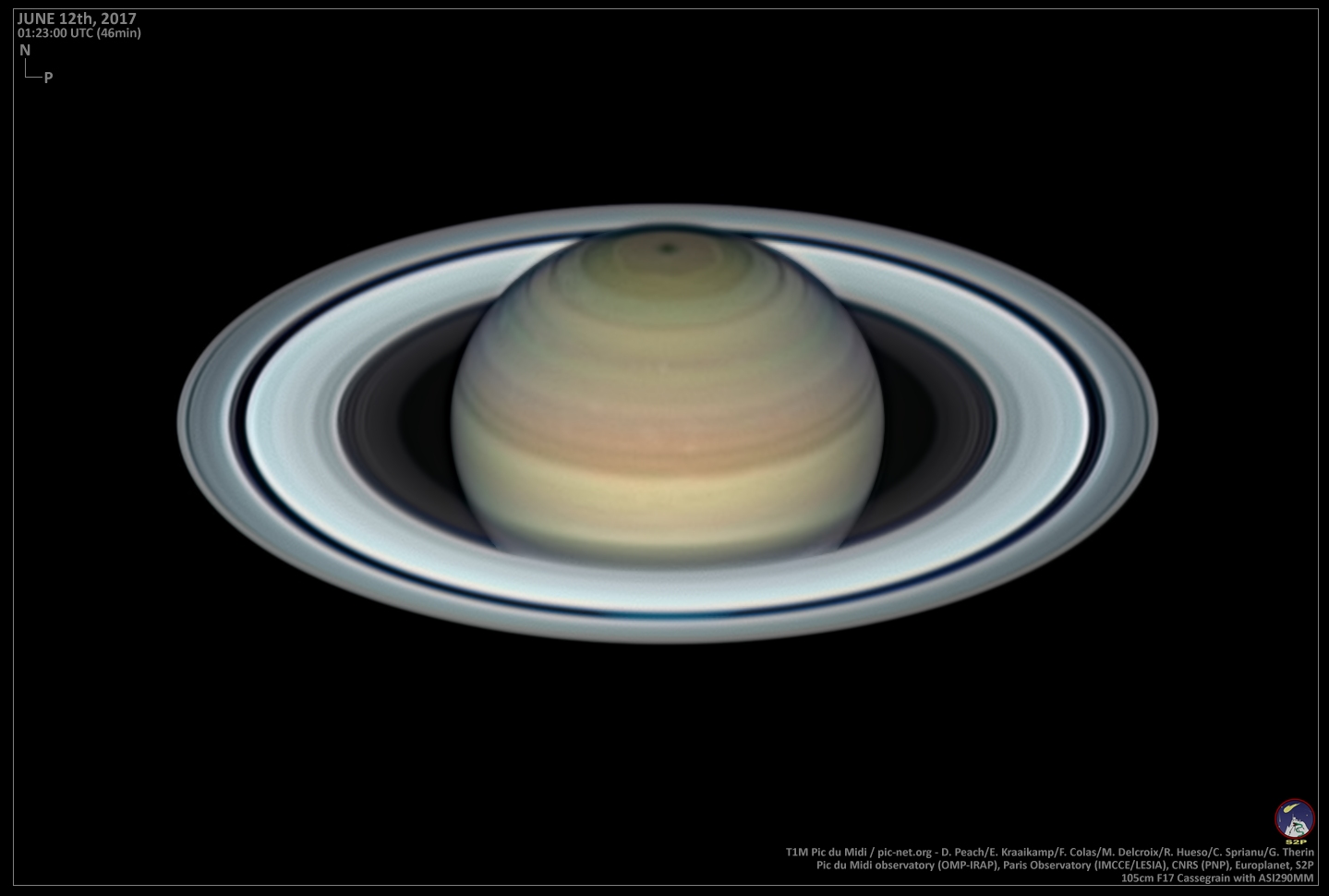
Mercury is dropping down from a nice apparition low in the dawn. But it is bright, about magnitude –1.0 all week. On Saturday and Sunday mornings the 16th and 17th it appears close to much fainter Mars, magnitude +1.8. After that Mercury drops fast morning by morning, while Mars moves just a bit higher.
Venus, brilliant at magnitude –3.9, shines as the "Morning Star" in the east before and during dawn. It's sinking lower toward Mars day by day. It passes Regulus (hardly brighter than Mars) on the mornings of the 19th and 20th.
Jupiter (magnitude –1.7) is disappearing deep into the sunset. Use binoculars to try for it just above the west-southwest horizon during bright twilight.
Saturn (magnitude +0.5, in Ophiuchus above Scorpius) glows in the south-southwest at dusk. Antares, less bright, twinkles 13° to Saturn's lower right.
Uranus (magnitude 5.7, in Pisces) and Neptune (magnitude 7.8, in Aquarius) are well up in the east and southeast, respectively, by late evening. Use our finder charts.
______________________
All descriptions that relate to your horizon — including the words up, down, right, and left — are written for the world's mid-northern latitudes. Descriptions that also depend on longitude (mainly Moon positions) are for North America.
Eastern Daylight Time (EDT) is Universal Time (UT, UTC, GMT, or Z time) minus 4 hours.
______________________
"This adventure is made possible by generations of searchers strictly adhering to a simple set of rules. Test ideas by experiments and observations. Build on those ideas that pass the test. Reject the ones that fail. Follow the evidence wherever it leads, and question everything. Accept these terms, and the cosmos is yours."
— Neil deGrasse Tyson, 2014
______________________
"Objective reality exists. Facts are often determinable. Carbon dioxide warms the globe. Vaccines save lives. Bacteria evolve when challenged by antibiotics. Science and critical thinking are not a political conspiracy. They are how we discover reality. Civilization's survival depends on our ability, and willingness, to do so."
— Alan MacRobert, your Sky at a Glance editor
______________________
"Facts are stubborn things."
— John Adams, 1770
 2
2








Comments
September 15, 2017 at 3:11 pm
For the next couple of weeks, if there is a halo around the sun at sunrise or sunset, look for "sun dogs" - the bright spots on the halo. There should be one above (north of) the sun, and one below (south of) it. Since the halo's radius is 22 degrees, the northern "dog" lies about where the sun rises/sets on the first day of Summer, and the southern "dog" lies about where the sun rises/sets on the first day of Winter
(For viewers in the Southern Hemispere, reverse the seasons for the "dogs").
You must be logged in to post a comment.
Ernesto
September 16, 2017 at 7:05 pm
Sunday is September 17th.
Thanks for your work,
Ernesto de Armas
Piperton, TN
• Before sunrise on Sunday morning September 16th, Mercury is only about 0.3° from dimmer Mars, as shown at right. Bring optical aid to scan for them very low in the east, 11° lower left of Venus. Along the way you'll hit Regulus, just a bit brighter than Mars.
You must be logged in to post a comment.
You must be logged in to post a comment.